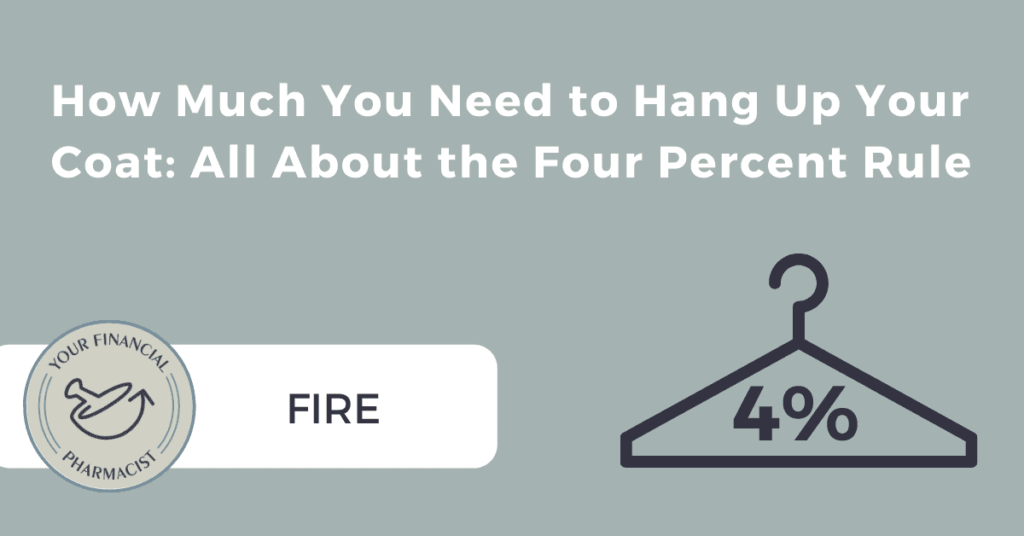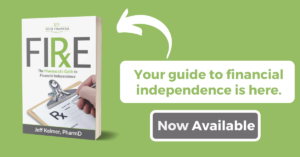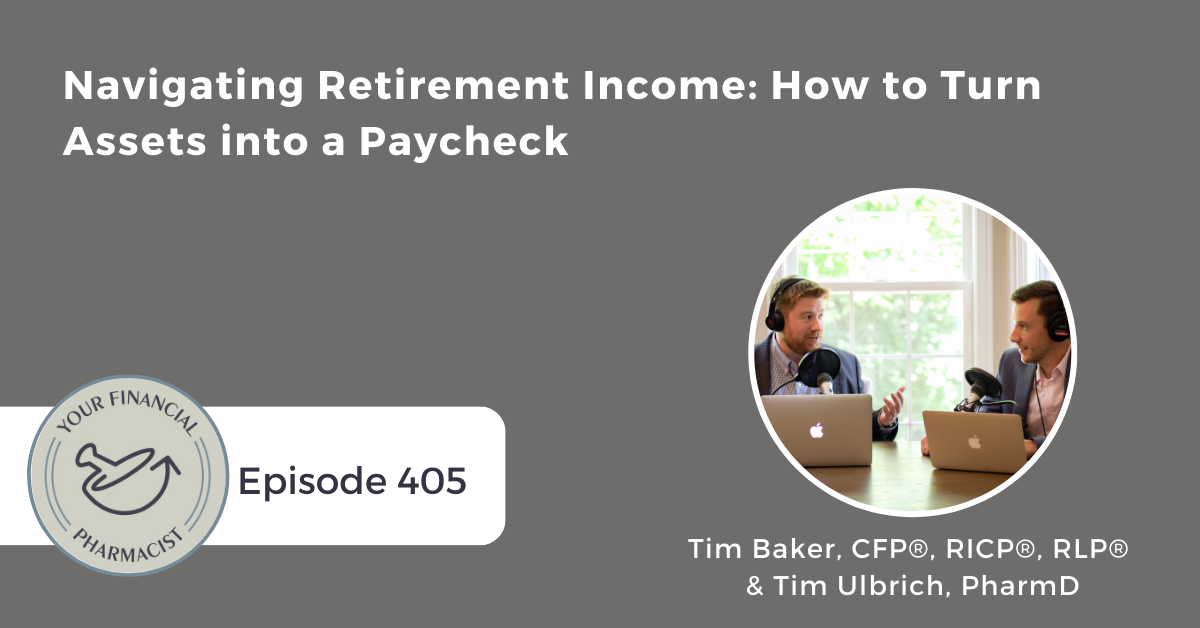How Much You Need to Hang Up Your Coat: All About the Four Percent Rule
The following is a guest post from Dr. Jeffrey Keimer. Dr. Keimer is a 2011 graduate of Albany College of Pharmacy and Health Sciences and pharmacy manager for a regional drugstore chain in Vermont. He and his wife Alex have been pursuing financial independence since 2016. Check out Jeff’s book, FIRE Rx: The Pharmacist’s Guide to Financial Independence to learn how to create an actionable plan so you can retire early as a pharmacist.
By now, you’ve probably heard that it’s possible to retire not just early, but incredibly early; like in your 30s or 40s instead of in your 60s or 70s. As evidenced by the financial independence, retire early (FIRE) movement, many people are doing just that. Now while that sounds awesome, the big question (as with most things) is always “how do you do it?”
In an earlier post, “The FIRE Prescription: How to Retire Early as a Pharmacist,” I gave a really broad overview of some of the basic tenets of the FIRE movement: the four percent rule, reducing expenses, investing, and drawdown of those investments. Having a good understanding of those concepts is crucial if you ever want to reach financial independence, but I didn’t go into much detail on any one of them in particular. Time to remedy that. So for this post, I wanted to take a deeper dive into that first concept: the four percent rule.
Why that one? Because it was the first one I listed. Duh.
On a more serious note though, the four percent rule (and by extension the concept of a safe withdrawal rate) should be the first thing to understand when drawing up a game plan for FIRE as a pharmacist. This is because it can help define the ever-elusive concept of “enough.” After all, what kind of journey do you set out on without a destination?
What is the Four Percent Rule?
When people in the FIRE community talk about the “four percent rule” what they’re referring to is a concept known as a safe withdrawal rate for early retirement. A safe withdrawal rate (SWR) can be defined as the annual amount (as a percentage) you can expect to withdraw from an investment portfolio without having to worry about the portfolio running out of money in the future; even as you adjust the initial amount for inflation year over year. Basically, you can look at your portfolio balance and figure out how much yearly income you can draw from it without worrying about the portfolio going to zero by assuming a safe withdrawal rate.
The “four percent” part comes in when we’re making assumptions about what kind of safe withdrawal rate our portfolio might support and it comes from a very important study published by financial planner, William Bengen, back in the early 1990s. In a nutshell, Bengen found that a diversified portfolio of US stocks and bonds could support at least a 4% safe withdrawal rate for retirees looking to tap their investments for retirement income over 30 years (more on that a little later).
Why it Matters
For those looking to join the FIRE movement, the four percent rule is probably the first major concept you get exposed to. Why? Because the whole idea of early retirement and the four percent rule do something incredibly important: it tells you where the endzone is. If you know how much you spend per year, you can use the four percent rule to define how much you need to save so that you can cover those expenses. Once you reach that number, sometimes called your FI number, you can probably declare yourself financially independent and consider early retirement.
So how do you calculate a FI number? Well, to borrow a phrase, it’s shockingly simple. Just take the inverse of 4% which is 25 and multiply your annual expenses by it.
For example, say your annual expenses (taxes included!) are $80,000. What’s your FI number?
$80,000 x 25 = $2,000,000
By using the four percent rule to help determine the amount you need to reach FI, not only do you set yourself apart from most Americans who frankly have no clue how much they need to retire, you give yourself a real number to work toward. With that in hand, you can measure your progress toward what many consider to be the ultimate goal in personal finance.
Given that, it’s no wonder that the four percent rule has become a chief cornerstone of the FIRE movement. What’s more, not only does it give you a concrete goal to work towards, it also puts that goal more firmly under your control.
Think about this for a second.
Many of us have been exposed to the advice that you need to save some multiple of your income by retirement to retire comfortably. But how much control do you really have over your income? As pharmacists, the answer to that question has to be “less than we’d like.” Many of us are all too aware of how much the market forces of supply and demand affect what we can expect in compensation.
That said, the four percent rule does something pretty spectacular. Instead of basing your retirement number on your income, it bases it off your expenses; something much, much more under your control. Cut out $500 a month from your budget? That translates to $150,000 less you’ll need to retire. The math is simple but incredibly powerful. What the four percent rule does, and I really can’t emphasize this enough, is that it gives you the knowledge to take control of your financial destiny!
Where Did it Come From?
Here’s where we’re going to get a little more technical and go over some of the research the four percent rule was born from, so buckle up. The four percent rule, as it’s come to be known, originally came out of the study “Determining Withdrawal Rates Using Historical Data” published in the Journal of Financial Planning by William Bengen in 1994. Bengen’s goal with the study was to shed some light on what kind of income a retiree could safely live on given a standard portfolio of stocks and bonds where the income produced came from the portfolio’s total return. And what did he find? By using historical return data on US stocks and US treasury notes, Bengen was able to conclude that the worst possible scenario for a retiree using a 50/50 stock and bond portfolio was that their money ran out after 33 years following a consistent 4% initial withdrawal strategy, indexing the withdrawal each year to inflation; a level Bengen referred to as SAFEMAX, and the rest of the world came to know as the four percent rule.
So how did that withdrawal strategy work? Like this. Say you have a $1,000,000 portfolio at the start of retirement. The first year, you’d draw $40,000 from it (4% of the initial balance). Next year, assuming a 3% rate of inflation, you’d increase the previous amount by 3% ($40,000 x 1.03 = $41,200) and that would be the amount withdrawn. In the years that come, just rinse and repeat. Slightly more complicated math than the FI number math, but still not too bad.
Bengen’s study was a watershed moment in the financial planning world. Before his study on withdrawal rates, retirement income planning either followed something akin to a reverse mortgage on the portfolio, reliance on pension income, or the old-school rentier model of only factoring in the income generated by the portfolio (i.e. not touching the principal). With Bengen, now the concept of a safe withdrawal rate could be incorporated into a retiree’s financial plan. His was just the first of many on the subject though.
Another piece of research that gets a lot of traction in the FIRE movement is one conducted by three finance professors from Trinity University dubbed, creatively, “The Trinity Study.” The Trinity Study more or less supported Bengen’s initial findings in that a 4% withdrawal rate tended to coincide with minimal risk of portfolio failure (i.e. going to zero) over a 30 year withdrawal period. The only real difference with the Trinity Study vs. Bengen’s was that the Trinity researchers presented their findings primarily in terms of probability of failure rather than just focusing on the lower bound results as Bengen did.
This was important to the whole safe withdrawal rate discussion because when making forecasts (as you do in the planning process) viewing things through the lens of probability is essential. In this case, the authors of the Trinity study placed the odds of success with a 4% withdrawal rate after 30 years at 95% using a 50/50 mix of stocks and bonds; a conclusion very much in line with Bengen’s and the notion of a 4% safe withdrawal rate.
So What’s the Catch?
So…despite the presence of studies and journals, finance isn’t what you’d call a hard science. Many would dispute the idea that it’s even a science at all. So here’s the tl;dr on how we should view the four percent rule: like the pirate’s code, it’s more of a guideline, not a rule.

Why is that?
First, let’s talk a bit about the works that gave us the four percent rule. Just like any of the drug studies you get to look at in your professional life, there are limitations; the most obvious of which is the sample size. For the vast majority of studies that look at historical withdrawal rates, sample sizes are quite small. Take, for instance, Bengen’s study where he looked at the experience of retirees from 1926-1976. Now that sounds like a big time period, but it’s really not. Each year studied assumed a January 1st retirement, so that gives us only 50 data sets. Try bringing a blood pressure med to market with a 50 subject phase III trial. Not gonna happen. To add insult to injury, many of the data sets he used included extrapolated (i.e. made up) data to get to their 50-year endpoints.
Now while the Trinity Study suffered from the same problem as well, some subsequent research has tried to increase the sample size to what you’d expect from a large-scale drug trial. For instance, in a 2017 paper titled “Safe Withdrawal Rates: A Guide for Early Retirees” published for the Social Science Research Network, Dr. Karsten Jeske (who runs the incredible blog Early Retirement Now) was able to expand the data set to 6.5 million retiree scenarios going back to 1871 and retirement periods of up to 60 years! To date, I’m pretty sure that his study is the most comprehensive and one that specifically targets a safe withdrawal rate for early retirement. Surely with that in hand, we can settle on some withdrawal rate as law right?
Nope!
Even such an incredible sample size is still too small. This is because Karsten’s study, like much of the popular research surrounding the four percent rule, is somewhat myopic in scope regarding asset allocation. Very few studies look at the impact of including international stocks (a very common diversification recommendation) in the portfolio, let alone alternatives such as real estate or precious metals.
Secondly, the studies in question didn’t consider investment fees and expenses (like taxes) whatsoever when drawing their conclusions. Kind of like the scenarios you find on a Physics 101 exam where you get to ignore friction, the scenarios described by the aforementioned studies may lack real-world applicability.
The third problem, and in my opinion the biggest one, is that, unlike a drug where we can reliably predict an average response given enough past data, markets don’t work that way. The only thing predictable about markets is that they’re unpredictable. The next 140 years may look like the last 140 years, or completely different. Who knows? Past data can certainly give you an idea of how they may behave, but they tell you nothing about how they will behave.
Perhaps a better approach here as suggested by Dr. Wade Pfau, a professor at the American College of Financial Services, would be to take the past data and use Monte Carlo simulations (remember those from stats?) to present the idea of an SWR in a more probabilistic fashion. I find this approach to be more useful as it can help you picture the relative odds of success based on how a portfolio tends to behave.
Should We Still Use the Four Percent Rule?
Absolutely, but not in the absolute sense. As I said earlier, it needs to be viewed more as a guideline instead of a rule. What I like about it in this way is that you don’t need to be precise with your math. If you can ballpark your yearly expenses using the four percent rule you can: set a savings goal for yourself, track your progress as you go, and, if you reach it, you can probably declare yourself financially independent.
Once there, should you quit your job, lock yourself into an automated withdrawal scheme, and move to the beach?
I wouldn’t.
Can you take some serious liberties with your career at that point?
Oh yes!
Despite its shortcomings, the four percent rule is all about giving you that goalpost where you can take those liberties. And the best part is that you don’t even need to get to that magical number to enjoy the perks! Just knowing where you are on the path can be incredibly powerful and open the door to new options in life.
For instance, when our son was born and my wife Alex wanted to stay home to raise him, we knew that we could do that from an income standpoint. But what about our goal of FI, how would the decision affect that? Thanks to the four percent rule, we could safely say that it wouldn’t matter that much. We knew where we were relative to our goal and we could go down to one income without really setting us back.
Or you could use it the way Cory and Cassie Jenks from Episode 134 of the YFP podcast are, in the pursuit of Coast FI. The four percent rule tells them how much they eventually need to be financially independent, but they’re not in a hurry to get there. Instead, they can take a look at their current savings and, using an assumed rate of return, determine the point at which they no longer need to contribute to their retirement savings. Once there, the money that would’ve gone to savings can go elsewhere…or not be needed at all! They can scale back work and not worry about sinking their eventual retirement.
But what if early retirement or stepping back from work isn’t your thing? No worries, the four percent rule has something for you too. Knowledge is power, and that power can present itself in many ways. One of which is knowing whether you’re in a position of financial strength or not when considering a job change, entrepreneurship, or some other calculated risk with your career. If you’ve done the math and you’re nowhere near FI, you may want to take a more defensive posture. But if you’re well on your way to FI or close to it, that calculus can change dramatically. It may even give you the license to pursue work that can better advance the profession even if it doesn’t pay much (yet!).
Conclusion
The four percent rule, despite its flaws, is a tremendously important tool in the FI toolbox. It allows you to create a concrete financial goal to strive for and one that you can track your progress towards. Once you have that, you can start down the path to FI.
On the path to FI, the four percent rule is just one of many concepts that you’ll want to learn to be successful. The four percent rule just tells you the destination, not how to actually get there; or perhaps equally important, what to do when you arrive. If you’d like to learn more about those things, I invite you to check out my new book FIRE Rx: The Pharmacist’s Guide to Financial Independence.
Current Student Loan Refinance Offers
[wptb id="15454" not found ]










One thought on “How Much You Need to Hang Up Your Coat: All About the Four Percent Rule”